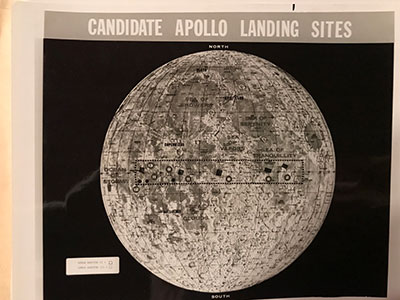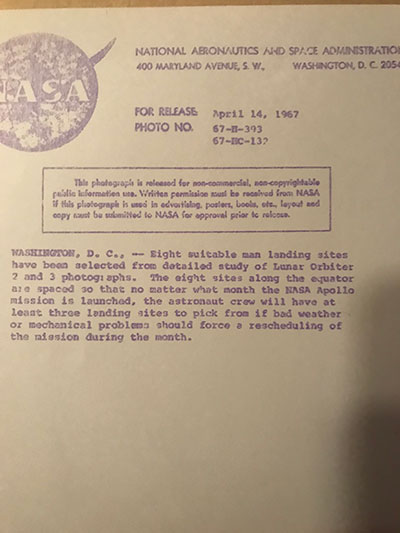|
Author
|
Topic: Proposed landing site named 'Apollo 7'
|
Explorer1
Member Posts: 202
From: Los Angeles, CA, USA
Registered: Apr 2019
|
 posted 04-23-2020 08:05 PM
posted 04-23-2020 08:05 PM
  
Is anyone familiar with a proposed lunar landing site for the H missions that was interestingly called "Apollo 7" (instead of something more traditional like "Littrow" or "Rima Bode")? I am guessing that this was a newly named region that was named in the Apollo 7 mission's honor. Is this correct? |
Fra Mauro
Member Posts: 1639
From: Bethpage, N.Y.
Registered: Jul 2002
|
 posted 04-23-2020 08:27 PM
posted 04-23-2020 08:27 PM
   
I've never heard of a proposed landing site named after anything other than a geographical feature. |
Robert Pearlman
Editor Posts: 43671
From: Houston, TX
Registered: Nov 1999
|
 posted 04-23-2020 09:22 PM
posted 04-23-2020 09:22 PM
   
Where was the "Apollo 7" designation referenced? While there are lunar craters named for the Apollo 1, Apollo 8 and Apollo 11 crew members, as well as Hugh Dryden and for the Apollo 8 mission (the latter named in 2018), I do not believe there are any regions on the moon named after any Apollo mission. |
Explorer1
Member Posts: 202
From: Los Angeles, CA, USA
Registered: Apr 2019
|
 posted 04-24-2020 10:57 AM
posted 04-24-2020 10:57 AM
  
I am going to have to locate the source I saw that in but "Apollo 7" was the H-1 site for Apollo 12 and alternately referenced to as the Western Mare/Surveyor VII site. Perhaps it was an abbreviation of sorts Apollo plus Surveyor VII. |
mmmoo
Member Posts: 556
From: London, England
Registered: May 2001
|
 posted 04-24-2020 11:04 AM
posted 04-24-2020 11:04 AM
   
The Apollo 12 landing site was also known as "Lunar Landing Site 7" as can be seen in this Landing Site Landmark Maps checklist page.Perhaps that has something to do with it? |
Explorer1
Member Posts: 202
From: Los Angeles, CA, USA
Registered: Apr 2019
|
 posted 04-24-2020 11:33 AM
posted 04-24-2020 11:33 AM
  
I think that is correct. Possibly an abbreviation Apollo Landing Site 7. But what does the 7 signify? Is that in reference to Surveyor VII? |
Headshot
Member Posts: 900
From: Vancouver, WA, USA
Registered: Feb 2012
|
 posted 04-24-2020 05:58 PM
posted 04-24-2020 05:58 PM
   
No, the 7 refers to the seventh potential Apollo Landing Site (ALS).In early 1969 Apollo managers had identified 5 possible landing sites for the first two Apollo missions. Eventually ALS 1 and 4 were eliminated whittling down the candidates to three, ALS 2, 3, and 5. After Apollo 11 landed on a "Blue" Mare at ALS 2, Apollo 12 was tasked with landing on a "Red" Mare. This eliminated ALS 3 ("Blue"). Then it was decided to also try for a pinpoint landing near a Surveyor spacecraft. This eliminated ALS 5. There were only two Surveyor sites on a "Red" mare, Surveyor I in Flamsteed Crater which was designated ALS 6R (don't ask); and Surveyor III in Oceanus Procellarum designated ALS 7. Eventually ALS 7 was chosen for the H-1 mission (Apollo 12). To my knowledge no one in any Apollo position of authority seriously considered landing a mission near Surveyor 7 for primarily operational reasons, although it was very high on many scientists' wish lists. |
Explorer1
Member Posts: 202
From: Los Angeles, CA, USA
Registered: Apr 2019
|
 posted 04-24-2020 06:46 PM
posted 04-24-2020 06:46 PM
  
What was the problem with the Surveyor VII site, and I have heard of the Blue and Red Mare. What do the two colors signify? |
Headshot
Member Posts: 900
From: Vancouver, WA, USA
Registered: Feb 2012
|
 posted 04-24-2020 09:35 PM
posted 04-24-2020 09:35 PM
   
The Surveyor 7 site was just at/beyond the very edge of the operational capabilities of Apollo. The believed it to be far too dangerous to attempt a landing at such a location.The Blue and Red Mare issue denoted spectral reflectivity differences between Eastern Mare and Western Mare. This was a BIG issue during the '60s. Scientists wanted to know what made the two types of mare different from each other. |
Explorer1
Member Posts: 202
From: Los Angeles, CA, USA
Registered: Apr 2019
|
 posted 04-25-2020 04:28 AM
posted 04-25-2020 04:28 AM
  
Did they ever establish what the reflectivity difference was?And also do you know what was the danger in the Surveyor VII site? Was it boulders? |
Fra Mauro
Member Posts: 1639
From: Bethpage, N.Y.
Registered: Jul 2002
|
 posted 04-25-2020 09:43 AM
posted 04-25-2020 09:43 AM
   
Surveyor 7 was the most southerly landing site in that program. To land there, would limit the LM's fuel reserves primarily and also limit payload capacity. That and the terrain eliminated that landing site. |
Explorer1
Member Posts: 202
From: Los Angeles, CA, USA
Registered: Apr 2019
|
 posted 04-25-2020 10:33 PM
posted 04-25-2020 10:33 PM
  
I think the Tycho crater was the southernmost destination and it had been planned for Apollo 20 to land there I believe. So the they definitely had the capacity to land in southern sites. But I could see where they would cancel such a destination for an early lunar landing. |
Mike Dixon
Member Posts: 1436
From: Kew, Victoria, Australia
Registered: May 2003
|
 posted 04-25-2020 10:46 PM
posted 04-25-2020 10:46 PM
   
Encyclopedia Astronautica: Apollo 20: Apollo 20 was originally planned in July 1969 to land in Crater Copernicus, a spectacular large crater impact area. Later Copernicus was assigned to Apollo 19, and the preferred landing site for Apollo 20 was the Marius Hills, or, if the operational constraints were relaxed, the bright crater Tycho. |
mmcmurrey
Member Posts: 116
From: Austin, TX, USA
Registered: Jun 2012
|
 posted 04-26-2020 09:06 AM
posted 04-26-2020 09:06 AM
   
Apollo candidate landing sites from April 14, 1967: 
|
Headshot
Member Posts: 900
From: Vancouver, WA, USA
Registered: Feb 2012
|
 posted 04-26-2020 11:22 AM
posted 04-26-2020 11:22 AM
   
The last set of recommended landing sites by the Apollo Site Selection Board (ASSB) in late October 1969 included Tycho as the prime site and Copernicus as the alternate site for Apollo 20. The idea being that Apollo would have effected nine landings and accumulated enough operational experience to risk a landing at Tycho.This did not happen due to the cancelling of Apollos 15, 19, 20 and the Apollo 13 accident. When Apollo management and operations performed a preliminary evaluation of the Tycho landing site option they were put off by the orbital mechanics and fuel usage (especially if a problem arose) to the point that George Low told the Group for Lunar Exploration & Planning (GLEP) there would be a mission to Tycho, "Over my dead body." These sentiments were later reinforced by Rocco Petrone and James McDivitt to the ASSB. Scientists, geophysicists and geologists making up GLEP and the ASSB never gave up trying to convince Apollo management to give Tycho a shot, especially after the success of Apollo 15. By then, however, there were only two missions left and Apollo 16 was already assigned to Descartes. The successor organization to GLEP/ASSB was searching for an Apollo 17 landing site that had many geological features created by different processes and Tycho did not offer that. |













